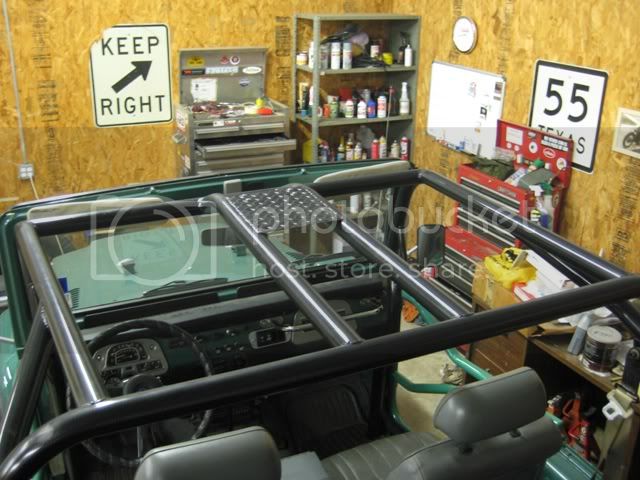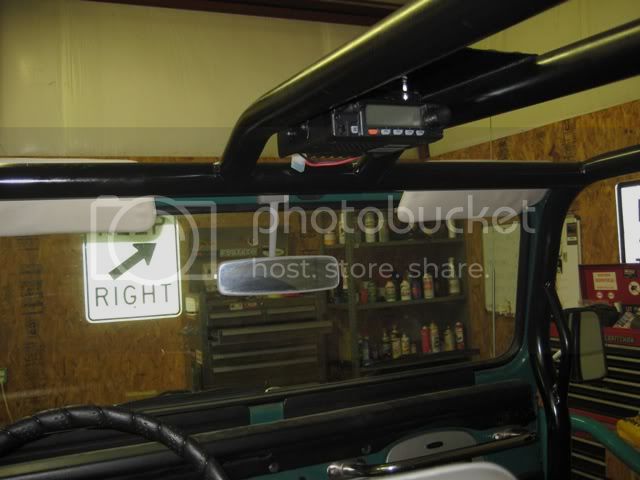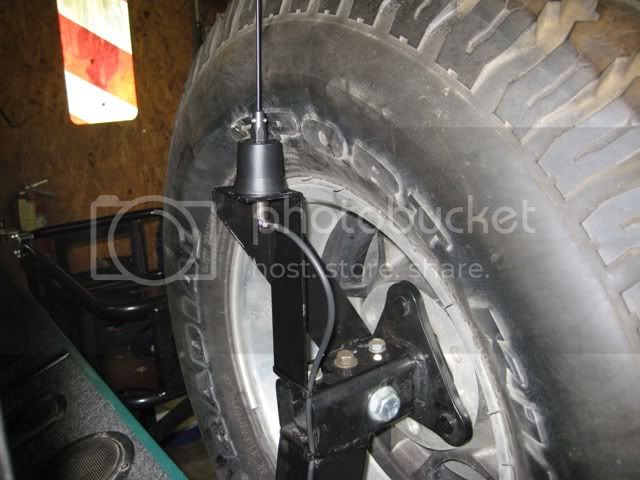1911
chupacabra
Been wanting to put a 2 Meter radio in the 40 for a while, but didn't want to rush it and end up moving it later. I really like the overhead mount in my FJC,

so I decided to do the same for the 40. When the MetalTech cage kit went together, I welded a piece of scrap steel plate between the two overhead bars, as forward as possible (up to the curve of the tubes). A thinner and flatter piece would probably have been better, but this was on hand:

It would be fun to have a fancy new radio (looked with longing at the Kenwood TM-D710A with built-in APRS and the Icom ID-880H with built-in DSTAR), but in a fit of common sense and budget I decided to just put one of the two Yaesu FT-2800M's I already own in for now. I put the overhead tubes of the cage far enough apart to fit most mobile radios up there I believe. The 2800 is actually a pretty large radio, since it has an oversized finned case for a heat sink instead of a fan. So maybe an upgrade later, but for now I can swap the 2800's between the two trucks and my base station as needed, and they're already programmed.
Overhead plate drilled, and the 2800 bracket mounted. I put a dab of black silicone RTV under the washers on top of the plate to try and seal against water on the uneven surface of the diamond plate. Probably anal since I almost always have either the bikini top or hard top on.


The radio mounted. I like how it is fairly protected by the cage bars, but still easily visible and accessible from either seat. I also really like the speaker on the bottom not far from my ear, as I'm hard of hearing anyway.


Now to hook up power, mount an antenna, and run the coax. Ordered a second power cord with the requisite "T" connector on-line; still waiting for it to arrive.
Because I use the hard top seasonally and don't want to drill any holes in the body if possible, I have decided to mount an antenna off of the back of the truck. After looking at several alternatives like the spare tire mount, I believe I will fab a piece of flat stock to bolt to the eight now unused holes that used to hold the stock spare tire swing-out:

I will weld-on or bend a 90-degree angle at the top big enough to drill a 3/4" hole in for an NMO mount. The hardest part looks to be putting a slight bend in the vertical piece of flat stock to match the curve of the body. I think the trick will be using flat stock that is thick enough to be sturdy but thin enough to form. I hope to make it sturdy enough to possibly hold an HF antenna later if desired. I figure I can also make it tall enough to get a few extra inches of height for the antenna. What do you guys think of this idea? There won't be much ground plane back there, so I guess a 1/2-wave antenna will be about the best I can do.
More later when I get more done. I would appreciate any suggestions or ideas for improvement you might have.

so I decided to do the same for the 40. When the MetalTech cage kit went together, I welded a piece of scrap steel plate between the two overhead bars, as forward as possible (up to the curve of the tubes). A thinner and flatter piece would probably have been better, but this was on hand:

It would be fun to have a fancy new radio (looked with longing at the Kenwood TM-D710A with built-in APRS and the Icom ID-880H with built-in DSTAR), but in a fit of common sense and budget I decided to just put one of the two Yaesu FT-2800M's I already own in for now. I put the overhead tubes of the cage far enough apart to fit most mobile radios up there I believe. The 2800 is actually a pretty large radio, since it has an oversized finned case for a heat sink instead of a fan. So maybe an upgrade later, but for now I can swap the 2800's between the two trucks and my base station as needed, and they're already programmed.
Overhead plate drilled, and the 2800 bracket mounted. I put a dab of black silicone RTV under the washers on top of the plate to try and seal against water on the uneven surface of the diamond plate. Probably anal since I almost always have either the bikini top or hard top on.


The radio mounted. I like how it is fairly protected by the cage bars, but still easily visible and accessible from either seat. I also really like the speaker on the bottom not far from my ear, as I'm hard of hearing anyway.


Now to hook up power, mount an antenna, and run the coax. Ordered a second power cord with the requisite "T" connector on-line; still waiting for it to arrive.
Because I use the hard top seasonally and don't want to drill any holes in the body if possible, I have decided to mount an antenna off of the back of the truck. After looking at several alternatives like the spare tire mount, I believe I will fab a piece of flat stock to bolt to the eight now unused holes that used to hold the stock spare tire swing-out:

I will weld-on or bend a 90-degree angle at the top big enough to drill a 3/4" hole in for an NMO mount. The hardest part looks to be putting a slight bend in the vertical piece of flat stock to match the curve of the body. I think the trick will be using flat stock that is thick enough to be sturdy but thin enough to form. I hope to make it sturdy enough to possibly hold an HF antenna later if desired. I figure I can also make it tall enough to get a few extra inches of height for the antenna. What do you guys think of this idea? There won't be much ground plane back there, so I guess a 1/2-wave antenna will be about the best I can do.
More later when I get more done. I would appreciate any suggestions or ideas for improvement you might have.
Last edited:

 Planning on building something similar at our place there in SF County though. Going to have to build the house first to keep the wife happy this time.
Planning on building something similar at our place there in SF County though. Going to have to build the house first to keep the wife happy this time. 










